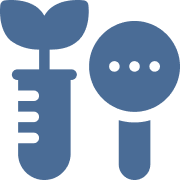Botany Homework Help - Best Online Help for Students
At TutorBin, we pride ourselves on offering the best botany homework help available online. We recognize that botany can be a challenging subject, with complex concepts and many topics. That's why we've gathered a team of experts who are well-versed in botany and can provide the guidance and support you need. Our botany homework help covers a wide range of topics, including plant anatomy, physiology, taxonomy, ecology, and more. Whether you're grappling with the basics of plant biology or diving into advanced botanical research, our expert botany tutors are here to assist you.
Botany Homework Help - Who Can Seek Botany Help Online?
Our online botany homework help is designed to accommodate students at all academic levels. Whether you're a high school student struggling with the fundamentals of plant biology or a college student exploring advanced botany topics, we have the expertise to cater to your specific needs. Every student is unique, and our services are tailored to provide personalized assistance. Whether you need help with a specific botany concept, clarification on a complex topic, or assistance with assignments and projects, TutorBin is the platform where you can find the support you require.
Botany Tutors Online - Is It Worth To Hire Them?
Our team of botany tutors consists of expert botanists and subject matter experts who have a deep understanding of the subject. They are not only passionate about plants but also well-equipped to guide you through the complexities of botany. When you seek assistance from TutorBin, you gain access to professionals who can explain complex concepts and provide practical insights to help you in mastering botany. Whether you have questions about plant classification, ecological interactions, or any other botany-related topic, our experts are here to help. This is the reason that makes students think of our experts as worthy resources.
Do My Botany Homework Help
Challenges Where Students Need Botany Assignment Help
Completing botany assignments can present significant challenges for students, prompting them to seek online assistance. These challenges can vary from struggling with complex plant biology concepts to limited access to relevant resources and time constraints. TutorBin botany assignment help is your solution to overcoming these hurdles. Here are some specific challenges that students encounter in the field of botany:
1. Complexity of Plant Biology Concepts
Botany assignments often involve intricate concepts related to plant physiology, taxonomy, and ecology. These complex botanical principles can be overwhelming, especially for students in the early stages of their botanical studies. Understanding and applying these concepts can be challenging without proper guidance.
2. Insufficient Instruction
Some students can receive inadequate or unclear instructions from their professors or educational institutions regarding botany assignments. This lack of clarity can leave students unsure how to approach their assignments, making external assistance essential.
3. Lab Report Writing Challenges
Botanical assignments often require students to compose lab reports based on their research and findings. Students can face difficulties accurately documenting their conclusions and interpreting results, which can significantly impact the overall quality of their assignments.
4. Data Analysis and Interpretation
Botanical research often involves collecting and analyzing data. Students can struggle with data analysis techniques, statistical tools, and drawing meaningful conclusions from their research findings.
5. Integration of Botanical Software
Some assignments can require students to use specialized botanical software for data analysis or modeling, such as R or SPSS. Integrating these software tools can be challenging for students unfamiliar with them.
6. Complex Botanical Terminology
Botany involves many complex scientific terms that can be daunting for students. Understanding and accurately using this specialized terminology in lab reports is crucial. Many students struggle with the precise definition and application of botanical terms, so seeking expert assistance is necessary.
7. Referencing and Citations
Accurate referencing and citing sources are essential in scientific writing. Many students struggle with citing relevant research papers, textbooks, and articles in the appropriate format (e.g., APA, MLA, or Chicago style). Incorrect referencing can lead to issues with originality and a loss of credibility.
Botany Topics & Concepts Covered
| TOPICS |
CONCEPTS |
| Plant Physiology |
Photosynthesis, Respiration, Transpiration |
| Plant Taxonomy |
Classification of plants |
| Plant Growth and Development |
Flowering and reproduction |
| Plant Ecology |
Ecosystems and habitats |
| Plant Evolution |
Adaptations and speciation |
| Plant Genetics |
DNA and genetic variation |
| Plant Diseases and Pathology |
Fungal, bacterial, and viral diseases |
| Ethnobotany |
Traditional plant uses |
| Horticulture |
Plant breeding |
Botany Assignment Help
What Do You Get When You Pay Someone to Do My Botany Homework?
When you choose TutorBin for your botany assignment help, you're making a wise decision that can significantly enhance your academic success. Our platform is committed to providing students like you with bst expert assistance in botany and various other subjects. Here's what you can look forward to when you connect with us for your botany homework help:
1. Concept Mastery
Strengthen your foundational knowledge by resolving doubts and gaining a better grasp of intricate botany concepts, including plant physiology, taxonomy, and ecology.
2. Comprehensive Botanical Assistance
Our experts provide support for various botany areas, covering plant biology, ecosystem analysis, plant identification, and more, ensuring you receive assistance tailored to your specific botany assignments.
3. Problem Resolution
Resolve complex botanical issues, including data analysis challenges, laboratory techniques, and ecological research errors, to ensure your botany assignments progress smoothly.
4. Customization & Report Writing Help
Learn to customize your botanical research through data analysis tools, crafting custom reports, and tailoring your botany work to meet your specific requirements.
5. Enhanced Visual Presentations
Elevate the visual appeal of your botany reports and research findings with advice on presentation techniques, data visualization, and creating professional assignment presentations.
6.Study Resources
Access a wealth of study materials, including informative video solutions and a comprehensive library of solved botanical questions, enriching your botany learning journey.
7. On-Time Submissions
Ensure punctual assignment submissions with the support of our expert botany tutors, who excel at managing deadlines and providing timely guidance.
To illustrate how our Botany assignment help works, let's consider an example. Imagine you have been assigned a Botany project on desert plant adaptations. Our experts will not only research and explain these adaptations thoroughly but also structure your assignment in a way that showcases your understanding of the topic. We aim to ensure that your botany assignments are not just completed but are of high quality, helping you earn top grades.
TutorBin Botany Homework Help
Students worldwide trust TutorBin for their botany homework help, and here's why we stand out:
1. Expert Botany Tutors
Our tutors aren't just educators; they are mentors dedicated to your academic success. Our diverse team includes subject-matter experts who possess the knowledge to solve botany assignments. These proficient tutors have substantial experience and practical insight, equipping them to handle various botanical assignments.
2. Personalized Approach
Recognizing the uniqueness of every student, TutorBin tailors its teaching to your individual learning style. Our botany tutors identify areas of struggle and offer targeted guidance to address those challenges.
3. Clear Explanations with Step-by-Step Guidance
TutorBin tutors excel at simplifying complex botany concepts. They provide clear explanations and clarify complex topics step-by-step, making them more accessible to students while ensuring correct answers and a deep understanding of the underlying processes.
4. Error-Free Solutions
Our tutors provide solutions that are thoroughly checked for errors before finalization. We offer step-by-step solutions that are not only explanatory but also easy to understand.
5. Deadline Adherence
Our skilled botany assignment tutors exhibit strong time management skills, ensuring timely completion of homework. This allows students to submit their assignments promptly when using our services.
6. Flexible Learning
TutorBin accommodates flexibility in scheduling sessions. Students can choose tutoring times that align with their availability, making learning seamlessly fit into their busy schedules.
7. Affordable Prices
We understand that students often have limited financial resources, so we have kept our prices competitive and affordable compared to others in the industry.
8. 24/7 Availability
Learning is not confined to a fixed schedule, and neither are we. Our expert tutor team remains accessible 24/7, day or night, to seamlessly assist you with your botany assignments. This continuous support empowers students to seek assistance from our experts at their convenience.
9. Original Work
At TutorBin, we maintain a strict policy for original work, and our subject matter experts fully understand its importance. After completing your assignment, we use originality-detection software to ensure its uniqueness.
10. Free Rewrites
In the rare instance that you're dissatisfied with our solutions, we offer students the option for rewrites, allowing for multiple modifications as per their requirements.
11. 100% Confidentiality
As a leader in online homework help, we uphold the utmost confidentiality and never share information with unaffiliated third parties. Our reputation is built on both the quality of our assignment assistance and our commitment to providing genuine, reliable services.
Botany Assignment Help - Expert Guidance for Your Academic Success
Are you facing difficulties with your botany assignments? Look no further! TutorBin is here to provide you with immediate and effective support. Our platform connects you with expert botany tutors who simplify challenging topics such as plant physiology, taxonomy, and ecology. They're committed to helping you navigate the complexities of botany and ensuring your academic success.
Whether you're struggling with complex plant biology concepts or need assistance with various botanical topics, our tutors guide you through each step of your academic journey. We understand the challenges of studying plant sciences and are here to bridge the knowledge gap. Whether you need clarification on scientific terms or assistance with lab report methodologies, our tutors ensure you are well-prepared to excel in your botany studies. Let us simplify problems and enhance your subject understanding. Don't let botany hold you back – conquer it confidently with the dedicated support of TutorBin experts.
Botany Homework Help Online - Accessible Worldwide
No matter where you are in the world, TutorBin comprehensive botany homework help is readily accessible and available 24/7. Our global accessibility ensures that you can conquer botany challenges, enhance your understanding, and succeed in your studies, no matter your location or time zone. With TutorBin, you can confidently tackle botany challenges, deepen your knowledge, and achieve academic success from any corner of the globe.
FAQs on Botany Homework
Can I pay someone to do my Botany homework?
Yes, at TutorBin, you can pay our qualified tutors to handle your Botany homework, which can help you better understand and improve your knowledge of the subject.
Where can I get help with Botany assignments?
When you need assistance with your Botany assignments, you can turn to platforms like TutorBin for expert Botany assignment help. Visit our website, specify your requirements, and we'll provide round-the-clock professional support to enhance your understanding and skills.
What should I do if I need help with Botany?
If you're looking for help with Botany, you're in the right place. Just submit your Botany assignment on TutorBin, and our tutors will provide the guidance you need.
How much should Botany homework help cost?
The cost of Botany homework assistance can vary and depends on factors such as the complexity of your assignments, the proximity of the deadline, and the availability of tutors.
Are there online Botany homework helpers available?
Yes! At TutorBin, you'll find online Botany homework helpers who can assist you with your assignments and coursework.










